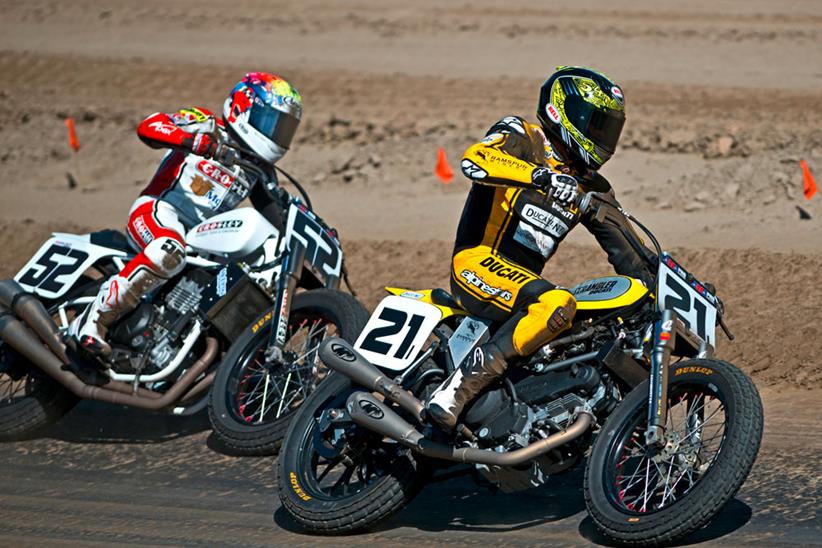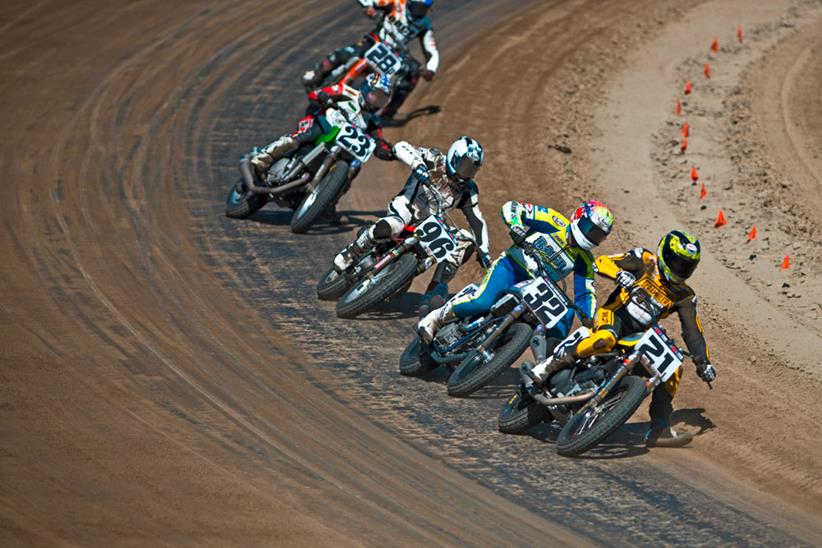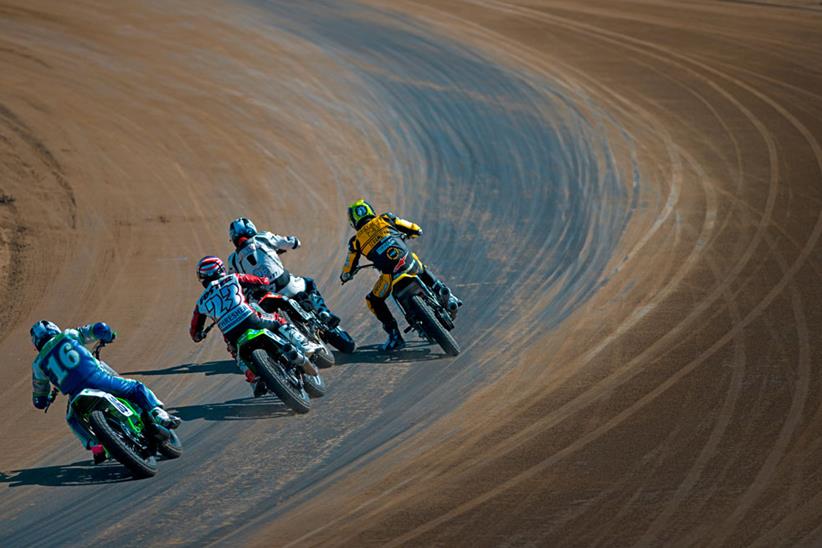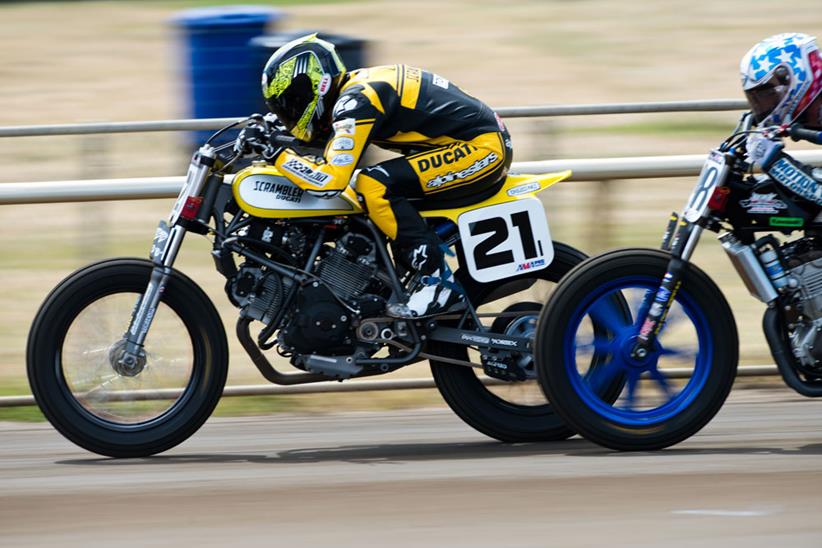Tory Bayliss: flat-out, even in retirement
Troy Bayliss is retired. Trouble is, he still loves racing. So, after dabbling with a WSB return, he decides to try US flat track. It doesn’t go to plan…
![]() blur of yellow flashes, like a comet, across the bottom of the huge screen. Somewhere on track, out of sight of my position at ground level on the start finish-straight, Troy Bayliss and his 1100cc Ducati flat track bike are heading for the air fence at over 115mph. A dream that has had the motorcycle world abuzz has turned sour.
blur of yellow flashes, like a comet, across the bottom of the huge screen. Somewhere on track, out of sight of my position at ground level on the start finish-straight, Troy Bayliss and his 1100cc Ducati flat track bike are heading for the air fence at over 115mph. A dream that has had the motorcycle world abuzz has turned sour.
The three-time World Superbike champion, MotoGP race-winner and, by general agreement, one of the good guys, has left his Australian home and family for a summer of racing professional US flat track at the very highest level. In lieu of a world championship, the AMA Grand National Championship is the 14-round annual series that determines the world’s best flat track racer. And Bayliss, a flat track fan, Australian champion and advocate of the sport, wanted a part of it.
“I grew up doing dirt track and since I retired I’ve supported our local club,” says Bayliss. After years of racing for the world’s best teams, working out of air-conditioned pit boxes I found myself back in the dirt and working on my own bikes, so I must love it.”
Steve McLaughlin, the former AMA Superbike champion and US racing mover-and-shaker, heard Bayliss was interested in the sport and invited him to compete at the Sacramento event McLaughlin was promoting.
‘It sounded like fun, but I’d only do it if I was riding a Ducati,’ says Bayliss.
Lloyd Brothers Motosports was a competitive team that have run Ducati-powered flat track bikes since 2009. But after sponsorship income dwindled the Lloyd Brothers, David and Michael, had decided to sit out the 2015 season. That decision was reversed when Bayliss came into the equation.
David Lloyd explains, “When Troy came along it attracted the Ducati enthusiast Jim Dillard. Vicki Smith at Ducati.net made the introduction, he stepped in and Ducati filled in the blanks. He loves Ducati and he wanted to bring Troy over.”
The fact the Lloyd brothers bike could be painted to look very similar, at a glance at least, to the new Scrambler made the whole deal a no-brainer.
It didn’t make sense to do just one race if it was possible to do more, so it was decided to compete in all five mile races the Grand National Championship (GNC) would visit in 2015.
![]() The GNC is made up of four different types of flat track events. This year there are two short track rounds, that take place on a small, quarter-mile oval at Daytona; two TTs, which are dirt track with lefts and right and, normally, one jump; five half-mile ovals; and the five miles, named after the length of the ovals, not the length of the race. Riders compete on modified 450 motocross bikes for the short track and TT races, and bigger twins in custom-built chassis for the half-miles and miles.
The GNC is made up of four different types of flat track events. This year there are two short track rounds, that take place on a small, quarter-mile oval at Daytona; two TTs, which are dirt track with lefts and right and, normally, one jump; five half-mile ovals; and the five miles, named after the length of the ovals, not the length of the race. Riders compete on modified 450 motocross bikes for the short track and TT races, and bigger twins in custom-built chassis for the half-miles and miles.
On Bayliss’s Sacramento race day, the team are allowed into the infield of the track at 11am. Four V-twin Ducatis are unloaded: two with Bayliss’s 21 front and side, in bold black numbers. The other two have the number 10 for his team-mate, Johnny Lewis.
David and Michael Lloyd push the bikes to tech inspection, which is taking place in the open air. While the Lloyd team are the only ones currently using Italian engines, the teams who are queuing up for their bikes to be scrutinised use twins from Harley-Davidson, Kawasaki, KTM, Triumph and Suzuki with a Yamaha FZ-07-powered bike in development. But the outright GNC champion has been mounted on a Harley-Davidson XR750 since 1993. That is some kind of dominance. The Milwaukee V-twin is the only pure race engine in the series, and it dates back to 1970. All the other machines use road bike engines. Races take place on dirt, with a Dunlop ‘spec tyre’ that David Lloyd describes as a 1970s bias-ply tyre. So while power is important, the right kind of power is crucial. Michael Lloyd says his team actually reduce the torque of the standard Ducati engine to try give the rear tyre an easier time.
Bayliss turned up to the first race, the famous Springfield Mile in Illinois on 24 May. No one doubted the talent of the man, but those who have followed the sport for years were quietly stating if Bayliss even qualified for the 18-rider final from an entry of 49, it would be incredible. As it turns out, he didn’t come close.
“I’ve never ridden a big bike [on the dirt]. I’m riding a Ducati 1100 and when you hop on it, it’s completely different [to a 450cc dirt tracker]. The first time I got on the bike I thought it was an alien. The first thing you notice is your left foot is way back and up high and your right foot is in a half-normal position. The bikes are big and need a different way of riding. Also, at Springfield, you can’t see the end of the corner. You can make it sound easy, it’s an oval and it’s only one mile but, of course, there’s a lot more to it than that.”
Now, less than a week later he has another chance. Riders have four laps of timed practice, four measly miles, to try get to grips with conditions.
Fastest lap time for the first session is set by reigning champion Jared Mees with 39.607s. Bayliss is 25th, less than a second off. While his experienced team-mate, Johnny Lewis is fourth, seemingly not suffering any ill effects of a 100mph get-off in the Springfield main. In the second round of times Bayliss is 27th, despite going 1.5sec quicker in his second session.
That highlights the other thing the riders have to contend with, and what Bayliss has very little experience of: the constantly morphing surface of the track. As the soft Dunlops are spun through the long, arcing corners they lay a ‘blue groove’ of rubber on the fastest line. The line become a metre or so wide. As lap times drop Bayliss struggles to stay online, and, as the locals say, he falls off the groove. Meanwhile a freight train of four riders rockets underneath him and slingshots down the straight.
![]() The Aussie gets on the tail, tucks down, chin on the tank, moves his left hand off the grip and holds near the fork leg. Bayliss gets in the draft and powers past. On the next lap he has a pair of riders behind him through the turns. He seems to be slowing them up slightly, but he gets great drive off the turn and even with the draft, the riders behind can’t get past. The Ducati is strong.
The Aussie gets on the tail, tucks down, chin on the tank, moves his left hand off the grip and holds near the fork leg. Bayliss gets in the draft and powers past. On the next lap he has a pair of riders behind him through the turns. He seems to be slowing them up slightly, but he gets great drive off the turn and even with the draft, the riders behind can’t get past. The Ducati is strong.
At the end of qualifying, the first year rookie Expert Jarod Vanderkooi is fastest qualifier with a time of 36.224s, nearly 3.5s faster that the quickest time in the first session. Bayliss has dropped to 31st overall, over 1.6s off the pole time. Johnny Lewis is in a solid sixth.
The large grandstand fills and the temperature drops below 30C. The national anthem is sung at 6pm, the first of the two support class heats goes off near to 6.45 and the Ducati Scrambler team prepares for their two heats. Troy comes last in his. Lewis is sixth, transferring straight to the main.
Troy needs to finish in the top three of his 11-rider semi to make the main. The race starts without him, but looking at the timing screens it seems Troy should be in the race. I wander towards the pit and there’s a panic. A team helper says the timings have changed without warning. The Ducati booms into life and Troy is slotted onto the back row of the second semi. No one seems to mind. If he were a real threat, other teams would protest his inclusion. As it is, they give the high profile visitor a break.
Within two laps he’s a yellow comet with a dusty brown tail behind him, heading for the air fence at 115mph. The fall results in a broken ankle.
The Lloyd team are understandably deflated, especially when Johnny Lewis can manage only 13th in the main. “What now?” I ask David Lloyd.
“We go back, fix everything and do better next time.” It’s the only way.
Words Gary Inman Pictures Yve Assad








